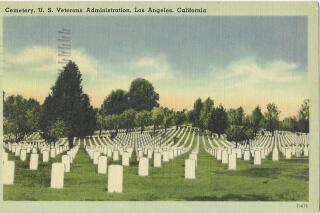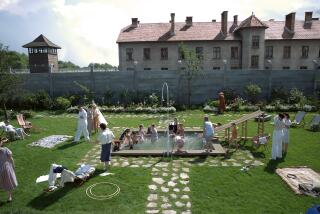Movie review: ‘In Heaven, Underground: The Weissensee Jewish Cemetery’
- Share via
It may not sound like it, but “In Heaven, Underground: The Weissensee Jewish Cemetery” is a playful, poetic and all-around charming documentary, an off-center look at an unusual institution.
That would be Berlin’s Weissensee, a 130-year-old veritable necropolis whose 115,000 graves make it the largest such establishment still in use in Europe. Yes, one of its administrators admits, there are a lot of dead people around, “but they don’t hurt you. It’s very peaceful.”
It’s also quite beautiful, a fully mature 100-acre forest in what was once East Berlin, and director Britta Wauer, working with cinematographer Kasper Kopke, has included numerous moments of random, unexpected beauty.
Wauer portrays Weissensee as a kind of magical place, filled with frequent bursts of life that range from the expected to the surprising. The film reveals the unforeseen ways death and life manage to intertwine because the cemetery has woven itself into the fabric of so many lives.
Because it is so old, Weissensee has a considerable number of huge mausoleums, some restored but others, as one observer says, so shaky “if you look at them sternly they fall over.”
The existence of these ostentatious mansions of the dead underlines one of the points “In Heaven, Underground” quietly makes, which is how central Germany’s Jews were to that country’s power elite. A ceremonial visit by an Israeli military unit to honor the Jews who died in World War I provides an opportunity to note that some 120,000 Jews volunteered for the army when Germany entered the Great War.
Another of “In Heaven, Underground’s” interviewees, Gabriella Naidu, makes a similar point. She visits the enormous mausoleum of her great-grandfather Adolf Schwabacher, once director of the Berlin Stock Exchange, and gives insight into what the lives of these powerful individuals were like.
While it is true that mourners searching for dead relatives make up a certain percentage of Weissensee visitors, “In Heaven” views them as just one color in a wide spectrum of unconventional people who find the cemetery irresistible.
Who would expect to find a young family that rents an apartment on the grounds or the high school art class devoted to making gravestone rubbings they later use in designing stones for themselves? And because Weissensee is such a deep forest, ornithologists doing serious birds of prey research show up to climb its trees and count the number of goshawk fledglings in cemetery nests.
It is sometimes the people with work connections to Weissensee, starting with feisty 84-year-old Rabbi William Wolff, who have the most affecting stories to tell. The son of a father who worked as a bricklayer at the cemetery, he describes falling in love among the memorial stones as a boy, and a coffin maker talks about how his work is a particularly satisfying act of charity because “dead people can’t say thank you.”
The coffin maker also reveals that his coffins are made without nails, so that eventually nothing remains in the ground but the bones of the interred. Other Jewish burial practices, like the custom of visitors leaving small stones on tombstones, are examined, and Rabbi Wolff talks about the religion’s lack of afterlife details: “The next world is vague because we live in this world.”
Finally, though, it is not any one moment but the combination of all of them that makes “In Heaven, Underground” such a satisfying experience. “Life affirming” are not the first words that come to mind to describe a film about a cemetery, but in this case they absolutely fit.
More to Read
The biggest entertainment stories
Get our big stories about Hollywood, film, television, music, arts, culture and more right in your inbox as soon as they publish.
You may occasionally receive promotional content from the Los Angeles Times.











